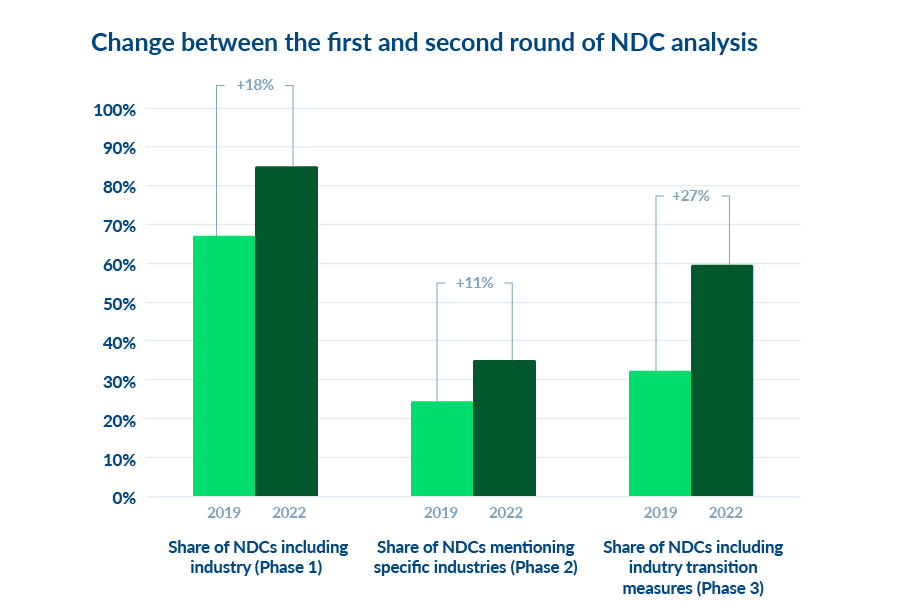2022 analysis of updated NDCs confirms progress in the coverage of industry transition.
Key messages
- An updated assessment of industry transition measures captured in the second round of Nationally Determined Contributions (NDCs) confirms that a majority of NDCs now include industry in their scope, and almost two-thirds include detailed industry transition measures, showing progress in the coverage of industry transition compared to the first round in 2019.
- The updated analysis shows that 12 out of the 15 highest industrial emitters specify mitigation measures that address industry. The assessment includes NDCs for most high emitting countries.
- Despite the increased attention being paid to industry transition for climate change mitigation, progress is too slow. The NDC process should be strengthened by identifying barriers to more detailed industry transition measures within NDCs and challenges to their implementation.
In 2021, LeadIT undertook an assessment of industry transition measures captured in the second round of Nationally Determined Contributions using our NDC Industry Scorecard . However, due to delays in the submission of NDCs, we could only capture 94 updated NDCs. Ahead of COP27 we have repeated the process with 134 updated NDCs to provide a more accurate picture. The updated assessment confirms the results of the assessment done in 2021. A majority of NDCs include industry in their scope, and almost two-thirds include detailed industry transition measures, showing progress in the coverage of industry transition compared to the first round in 2019.
Positive overall change between the first and second rounds of NDCs
As shown in Figure 1, there has been an increase in the proportion of parties including (a) industry in the scope of their NDC; (b) mentioning specific industries such as steel and cement; and (c) including domestic mitigation measures targeting emissions from industries.

Despite the increased attention being paid to industry transition for climate change mitigation, progress is too slow
The results show that industry transition is being increasingly included in the scope of NDCs. These findings are in line with those from the UN Climate Change 2022 NDC Synthesis Report which found that 47% of parties refer to industry as a specific priority area for domestic mitigation measures.[1]
Increase in detailed industry transition measures
Looking at the level of detail in mitigation measures targeting industry, we found that out of the NDCs that included such measures: 44 (55%) scored low; 23 (29%) scored medium; and 13 (16%) scored high. The 13 parties that scored high were China, Dominica, Egypt, Guinea, India, Indonesia, Japan, Jordan, Malawi, Morocco, Paraguay, Rwanda and Uganda.

For 124 parties, we were able to compare their scorecard for both rounds of NDCs. We found that one-third of analysed parties went from not having any industry transition measures detailed in their first round NDCs to having either a low (28 parties), medium (9 parties), or high (4 parties) level of detail of specific domestic industry transition measures in their most recent NDC.
The significant increase in NDCs containing detailed industry transition mitigation measures shows that NDCs are increasingly being used as a platform to outline policy initiatives, moving beyond stating goals to setting out concrete actions to meet them. NDCs should send clear signals to industries around the world to induce accelerated investments and create long-term support to industries undergoing decarbonization.
Mixed picture among the heaviest industrial emitters
The heaviest industrial emitters with updated NDCs account for over 80% of global industrial process greenhouse gas (GHG) emissions.[2], [3] Table 1 shows that fewer heavy emitters have omitted some level of detail on industry measures from the scope of their latest NDCs – 3 out of 15 received ‘no score’ compared to 5 in the first round of 2019. However, despite fewer parties with ‘no score’ ratings, these parties, the EU, Russia, and Thailand contribute to roughly 10 percent of global industrial emissions. To better understand the seemingly missing industry transition measures, read the analysis of three high-emitting countries with no score done in 2021.
NDCs do not provide the full picture of measures in place and examining and understanding the political context at a national level can provide a better indication of the priority placed on industry transition. However, NDCs play an important role for policymakers, industry, and civil society, and contrary to the spirit of ratcheting up ambition, The NDC process should therefore be strengthened by identifying barriers to more detailed industry transition measures within NDCs and challenges to their implementation.

References:
[1] UN Climate Change, NDC Synthesis Report, 2022
[2] CAIT, Climate Data Explorer, 2018.
[3] Although a large proportion of the GHG emissions produced by industry originate from direct and indirect energy consumption, we used industrial process emissions as a proxy for total industrial emissions due to the challenges of disentangling data for industry from energy.
